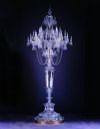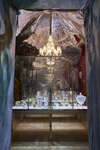How the Luxury Brand Baccarat Turned Things Around: “It Goes Beyond a Piece of Crystalware”
As a devotee of the values of French art de vivre and its ambassadors, Christian Razel attended a “Dandy & Plumes Party” in Baccarat’s luxurious hôtel particulier (private mansion) in Paris. He returned a few days after the party to have an exclusive conversation with Madame Daniela Riccardi, the Managing Director of Baccarat.
Baccarat was founded in 1764 by decree of King Louis XV. Over the course of more than 250 years, this brand has become a symbol of excellence and French art de vivre.
What is Baccarat’s motto nowadays?
The brand’s motto could be summarized as “La Vie en Baccarat” (Life in Baccarat). It goes beyond a piece of crystalware. It is the art of hospitality, the art of giving, soirées, parties—in a word, sharing. Our priority is the Baccarat experience. It is at the heart of our strategy, which aims to make the brand a part of people’s everyday lives.
Christian Razel: Why did your new Chinese shareholder, the family office Fortune Fountain Capital (FFC), decide to acquire Baccarat, a French crystal-making company, in June 2017?
Daniela Ricardi: Madame Coco Chu manages the family office FFC, which represents very wealthy Chinese families. Madame Chu is deeply involved in the luxury sector. She is very well educated, she is a Francophile, and she knows the world. This businesswoman has a global vision for her “family office” and Baccarat is her first investment in the world of luxury brands. For her, this brand is a living treasure that represents international and French art de vivre. She wants to introduce the Baccarat experience to the very wealthy in China so they can experience the refinement of French art de vivre by surrounding themselves with luxury products that exemplify exceptional savoir-faire. For Madame Chu, the brand could also enrich the hotels she would like to open in China with this same art de vivre.

Anna Wang, Vice President of FFC and Cocu Chu’s mother;
Daniela Riccardi, Managing Director of Baccarat; Coco Chu, President of FFC
What are the current ambitions of Baccarat and its Chinese shareholder FFC?
Our new Chinese shareholder envisions “a new golden age” for Baccarat in the years to come, which would translate into greater brand visibility through the development of a network of shops in Europe, China, and big cities like Singapore and Los Angeles. There would also be investment in brand digitalization and social media, including WeChat in the People’s Republic of China. Our plan is to target millennials because 70% of the growth of luxury brands is driven by 25- to 35-year-olds. This plan will involve a unique immersive experience of the product based on sharing. For example, the case of wine glasses, “Château Baccarat Tasting: Four Châteaux in One Red Box” includes one white wine glass, one red wine glass, a champagne flute, and a tumbler. Drinking wine is a social experience for millennials. We will charm them with the attractive price of €195 for this product, which represents an entry point into the world of Baccarat. Of course, we have not forgotten about our loyal customers.

"Four Châteaux in the Red Box "
We intend on developing our business in adjacent areas of the luxury market through partnerships with other luxury brands. For example, we signed an agreement with the parfumier Francis Kurkdjian to mark the 250th anniversary of Baccarat with the re-release of a perfume created by Georges Chevalier in the 1940s. The fragrance, inspired by Baccarat’s signature red color, was developed by Francis Kurkdjian. Rouge 540 has been a huge success because it was created with passion. In any case, we anticipate investing tens of millions of euro to enhance our production equipment and accelerate our international development. As we wait for the last administrative obstacle to be removed by the Chinese authorities so FFC can become the full owner of Baccarat, the money generated by the company will allow us to make our first investments.
What are the specific expectations of Chinese customers?
At present, we have one shop in Beijing and another in Shanghai. We want to open a dozen more in China, with a Baccarat bar near each shop so our Chinese friends and clients can enjoy a unique immersive experience of the brand. As regards hotels, we have signed an exclusive, long-term worldwide licensing agreement with Starwood, with very strict specifications to ensure that the brand’s unique character and the experience of the product are respected. A Baccarat hotel in China is only possible through an agreement with Starwood in the form of a new license, covering, for example, hotels of different sizes to the New York hotel, such as boutique hotels.
The Chinese appreciate French savoir-vivre, including how to hold a glass, lay a table, or even simply receive guests at home. We have, moreover, received special orders from very wealthy Chinese customers. We will not be developing products especially for the Chinese market as the Baccarat lifestyle is global and international.

Who is responsible for designing products at Baccarat?
Baccarat has always worked with internationally renowned designers. Georges Chevalier was Baccarat’s first artistic director, from the 1920s until the 1970s. We then collaborated with designers such as Philippe Starck, Ettore Sottssass, Patricia Urquiola, Marcel Wanders, Arik Levy, the Campana brothers, and Thomas Bastide. The designers come to us with a concept—and not just a product—through which they reinterpret the brand without abandoning that which defines Baccarat. These collaborations have been a great success for the brand. The products are modern, timeless, and iconic. Baccarat is always innovating.
What are the themes of your 2018 collections?
The new 2018 spring/summer collection, “Golden Days of Blue Jazz,” was presented at a big party inspired by the famous balls thrown by Marie-Laure de Noailles in Baccarat’s hôtel particulier. At this event, we revived the “Roaring Twenties” of the brand through new pieces inspired by the Art Deco period and created by Georges Chevalier, such as the Louxor Vase.
Reminiscent of The Great Gatsby, this big Parisian party allowed people to experience the splendor of the Baccarat brand in situ over the course of the evening.
The Art Deco era was chosen for our new collection because it corresponds to the brand’s transition from the period of kings, maharajahs, and tsars to modernity.


Dandy & Plumes Party: Francis Kurkdjian and Daniela Riccardi © François Goize
What might the theme for your 2018 fall/winter collection be?
We have yet to finalize our choice, but we’re thinking the 1970s because such beautiful works were created during this period and we could bring these back. We create new stories on the basis of our heritage.
How is this unique and timeless savoir-faire passed on?
Thanks to its artisanal focus, Baccarat has at its disposal exceptional savoir-faire for making crystalware by hand that goes back over 250 years and that is transmitted from generation to generation by an internal training school run by Maîtres d’Art (Masters of Art) and the Meilleurs Ouvriers de France (Best French Craftspeople). Today, Baccarat counts among its staff more Meilleurs Ouvriers de France than any other French luxury brand.

Baccarat men at the factory in Baccarat in Meurthe-et-Moselle © Kevin Sinclair

BACCARAT IN A FEW WORDS/FIGURES:
11 Place des Etats-Unis, 75116 Paris. www.baccarat.fr
- The company was founded in 1764.
- The company was listed on the Paris Stock Exchange, with a market value of €181 million, on February 9, 2018.
- 990 staff (including 511 at the factory).
- Turnover in 2016: €148.3 million.
- 15 Meilleurs Ouvriers de France and 1 Maître d’Art.
- The Baccarat, Timeless Modernity exhibition at the Musée Baccarat: 300 pieces that are representative of Baccarat, from the famous Harcourt glass made in 1841 to the masterpieces of the world fairs.
- Baccarat, a symbol of French art de vivre that is lauded across the world, was designated an Entreprise du patrimoine vivant (Living Heritage Company) in 2007; it is a member of the Comité Colbert; and it represents the excellence of French culture and identity. As an emblematic French producer of tableware, Baccarat pays homage to French cuisine, which was included by UNESCO on its List of the Intangible Cultural Heritage of Humanity.

Baccarat archives: Harcourt Service, 1841 © Patrick Schüttler

© Baccarat archives: “The Tsar’s Candelabra,” made for Tsar Nicholas II in 1896


Baccarat Museum



